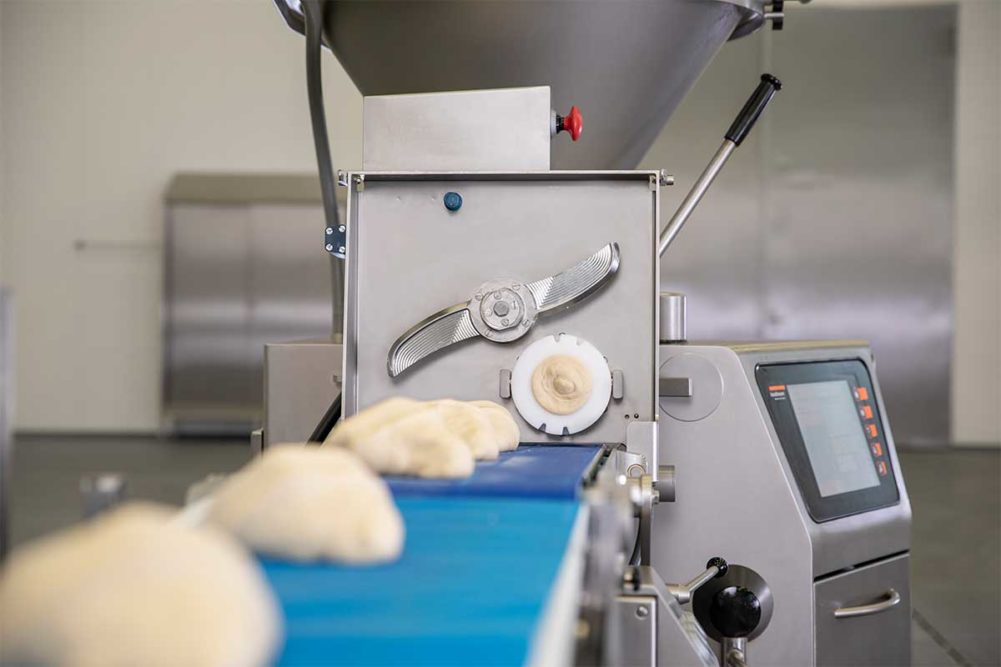Choosing the right divider and rounder for each job is critical for bakeries to run quickly and efficiently. That includes ensuring the rounding system will accommodate their scaling range and desired piece per minute. Additionally, bakeries must have the correct belt, bar size and material for the doughs they’re running, which can include Teflon-coated, oil-impregnated or aluminum. It may require some trial and error to get it all right.
“You might have a very sticky dough, so you want oil-impregnated rounder bars,” said Jim Fontaine, bakery field sales manager, Reiser. “Some people with extremely sticky doughs would rather use aluminum. It depends on the dough consistency and what bar is going to work best grabbing that dough and rounding it up without getting a lot of material sticking to it. That’s why you have those different materials that you can try.”
It’s important for bakeries to run machinery at the speeds that make sense for their products.
“There’s usually a timing cycle when you introduce the piece to the rounder,” said Ken Hagedorn, vice president of the bakery sector for Handtmann. “If people are not diligent on that transfer, they’re trying to get the pieces too close together. They’re trying to increase their capacity by not keeping their deposits two seconds apart, which will cause issues. What compounds that is if they don’t do a good job with dusting flour. If they’re delinquent in adding dusting flour, then the dough balls tend to slow down as they’re going through the rounder. They have a tendency to catch up to each other, and then you start getting doubles.”
Gluten-free doughs have a wide range of consistencies, from batters to a conventional bread dough, he added, and they can also cause challenges.
“You can’t use dusting flour unless you’re going to use gluten-free dusting flour, and that is as expensive as can be, so bakers are going to tend to stay away from that,” Mr. Hagedorn said. “You can’t use oils because oils are too slippery. If you put oil through a rounder, the dough’s just going to slip and slide all over the place. It probably won’t even roll.”
Equipment should be adjusted for each product to ensure optimum efficiency.
“The distance between the rounding cone, which is spinning, and the track, which creates the tension, is critical,” said Nate McDermott, director of customer service, WP Bakery Group USA. “Our rounders have adjustable tracks that are tailored specifically to the size of the dough piece and the consistency of the dough. Factory tests are always recommended to ensure the bakery selects the correct track size and rounder style for each application.”
Rondo has a robotic system that simulates manual round moulding for artisan rolls and bread. The Rondobot can process highly hydrated dough in a wide range of weights.
Testing is key to ensuring that bakeries choose the right rounder.
“Target shape and weight range have a huge impact on the quality of the finished products,” explained Jerry Murphy, vice president of sales, Gemini Bakery Equipment/KB Systems.
Daniel Habel, integration manager, AMF Bakery Systems, said the closer the mixing process is to a continuous system, the better it is for the dividing.
“Small batches combined with AMF’s high-speed extrusion dividers minimizes beginning-to-end fluctuations in the dough,” he said.
Gentle handling helps maintain dough structure, especially for artisan-style breads.
“Bakers know they have the right divider and rounder when the product they are making looks and tastes like it is handmade,” said John Giacoio, vice president of sales, Rheon USA. “Too many bakers settle for automation just because they can make products faster. It also has to be about the quality.”
This article is an excerpt from the October 2022 issue of Baking & Snack. To read the entire feature on Dividing & Rounding, click here.




